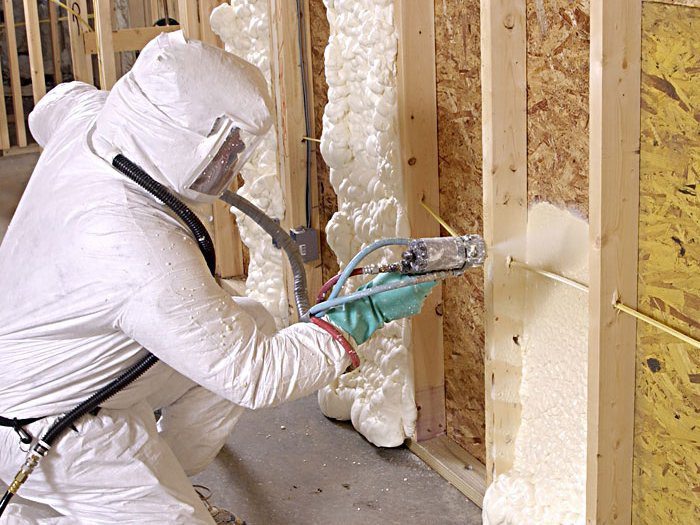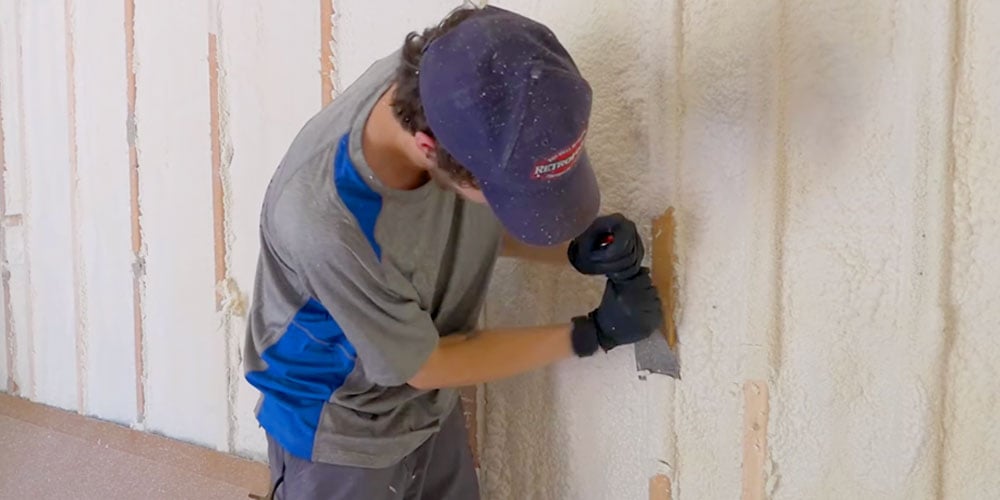Spray Foam: The Ultimate Solution for Air Sealing and Insulation
Spray foam insulation has actually emerged as a leading option for effective air sealing and thermal insulation, using a distinct mix of residential properties that set it aside from standard approaches. Its ability to broaden and fill spaces makes it specifically reliable in avoiding air leakage, which can dramatically affect power performance. Recognizing the complete scope of its benefits, installation processes, and comparisons with other insulation types is essential for making notified decisions. As we check out these elements, the effects for both brand-new buildings and retrofits end up being progressively considerable. What aspects should affect your option?
What Is Spray Foam?
Spray foam is a flexible insulation material that incorporates the concepts of air sealing and thermal resistance to boost energy performance in structures. Composed mostly of polyurethane or other similar substances, spray foam is used as a liquid that increases upon contact with surface areas, producing a solid, continual layer of insulation. This distinct residential property allows it to load spaces, cracks, and spaces that traditional insulation products may forget, providing a premium air seal.
There are two major types of spray foam: open-cell and closed-cell. Open-cell spray foam is lighter and more versatile, offering exceptional sound absorption and a reduced R-value per inch - Spray Foam. In contrast, closed-cell spray foam is denser, supplying a greater R-value, wetness resistance, and included structural stability to building elements
The application procedure usually involves specific tools, guaranteeing a smooth application that follows different substrates, including metal, concrete, and wood. This flexibility makes spray foam appropriate for both brand-new constructions and retrofitting existing structures. Its capacity to create a closed obstacle significantly adds to lowering energy consumption and enhancing interior air high quality, thereby making it a preferred option amongst builders and house owners alike.
Advantages of Spray Foam Insulation
One of the most substantial advantages of spray foam insulation is its exceptional capability to produce a continual air barrier, which properly reduces power loss. Unlike typical insulation materials, spray foam expands to fill up spaces and splits, making certain that air leakage is dramatically minimized. This particular not only enhances energy efficiency yet additionally brings about decrease energy expenses in time.
Additionally, spray foam insulation provides superior thermal resistance, adding to a much more stable interior atmosphere. Its high R-value per inch permits effective insulation in restricted rooms, making it excellent for attic rooms, walls, and crawl spaces. The moisture-resistant residential properties of spray foam assistance prevent mold and mildew and mildew development, promoting healthier living problems.
Another critical advantage of spray foam insulation is its sound-dampening qualities (Spray Foam). It properly minimizes noise transmission in between rooms, developing a quieter and much more comfy home environment. The durability of spray foam additionally stands apart, as it does not droop or work out with time, preserving its efficiency throughout its life expectancy
Just How Spray Foam Works
Recognizing how spray foam insulation functions is important for valuing its efficiency in air securing and thermal resistance. Spray foam insulation contains 2 primary elements: isocyanate and polyol material. When these components are blended, they undertake a chain reaction that creates the material to broaden swiftly, creating a dense foam that fills up voids, cracks, and tooth cavities.
As the foam expands, it complies with surface areas, creating an airtight seal that substantially lowers air seepage. This characteristic makes spray foam insulation highly efficient at protecting against drafts and moisture penetration, which can result in energy loss and damages gradually. In addition, the closed-cell version of spray foam offers superior thermal resistance as a result of its inflexible framework, properly minimizing heat transfer.
The unique homes of spray foam enable it to adapt uneven surfaces, guaranteeing extensive protection and a seamless barrier. Consequently, spray foam insulation not just improves energy efficiency however also adds to improved indoor air high quality by reducing the accumulation of irritants and pollutants. Eventually, comprehending the mechanics behind spray foam underscores its duty as a premium option for insulation and air sealing in both business and property applications.
Setup Process Review

Prior to installation, the area needs to be adequately cleaned up and prepped, making certain that surfaces are totally free from dirt, particles, and dampness. Since impurities can compromise adhesion and overall performance, this step is essential. When the area is prepared, the application includes mixing the 2 parts of the spray foam, which increases upon contact and fills gaps effectively.
Trained experts ought to carry out the setup, using specific equipment to guarantee uniform coverage and optimal density. Security safety measures, consisting of using protective gear and ensuring proper air flow, are important during this procedure. After application, the foam typically treatments swiftly, developing a solid barrier that boosts power effectiveness.
Comparing Spray Foam to Typical Insulation
When reviewing insulation alternatives, spray foam insulation attracts attention in comparison to conventional products such as fiberglass and cellulose. Among the primary benefits of spray foam is its remarkable air sealing capabilities. Unlike fiberglass and cellulose, which can permit air infiltration, spray foam increases upon application, filling up gaps and holes read here to develop a closed seal. This results in improved energy performance, as less warmed or cooled air escapes the home, causing lower energy bills.
Furthermore, spray foam provides a greater R-value per inch than traditional insulation types, offering more reliable thermal resistance in a thinner profile. This particular is especially beneficial precede with minimal tooth cavity deepness. Additionally, spray foam is immune to moisture and mold development, which can be a significant interest in cellulose and fiberglass, particularly in moist environments.
Nonetheless, spray foam insulation generally lugs a greater in advance price than its conventional equivalents. Homeowners should evaluate this first financial investment against long-lasting power financial savings and efficiency benefits. Ultimately, while both insulation kinds offer their purpose, spray foam becomes an advanced option for modern-day insulation demands, specifically in regards to this contact form air securing and thermal efficiency.

Conclusion
In recap, spray foam insulation stands for a very efficient option for accomplishing ideal air sealing and thermal resistance. Its unique residential or commercial properties, including moisture resistance and audio dampening, make it ideal for different applications in both new constructions and retrofitting projects (Spray Foam). Although the first prices may be higher compared to conventional insulation materials, the lasting advantages, such as considerable energy financial savings and enhanced indoor air quality, warrant the investment and underscore its worth in contemporary building techniques.
Spray foam insulation has arised as a check over here leading service for reliable air sealing and thermal insulation, supplying a distinct mix of residential properties that set it apart from typical methods.Spray foam is a functional insulation material that integrates the principles of air sealing and thermal resistance to boost energy effectiveness in structures.When examining insulation alternatives, spray foam insulation stands out in comparison to standard materials such as fiberglass and cellulose. Eventually, while both insulation kinds offer their purpose, spray foam arises as an extra advanced option for modern-day insulation needs, specifically in terms of air securing and thermal efficiency.
In recap, spray foam insulation stands for a highly efficient remedy for achieving optimal air sealing and thermal resistance.